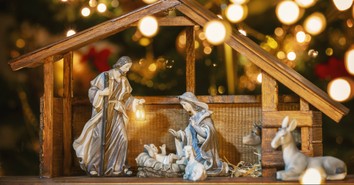Praying the Names of God - August 13
From Praying the Names of God Week Nine, Day Three

The Name
Ancient armies carried standards or banners that served as marks of identification and as symbols that embodied the ideals of a people. A banner, like a flag, was something that could be seen from afar, serving as a rallying point for troops before a battle. Though banners were first used in Egypt, Babylonia, Assyria, and Persia, the Israelites carried them on their march through the desert. When you pray to Yahweh Nissi, you are praying to the God who is powerful enough to overcome any foe.
Key Scripture
Moses built an altar and called it The LORD is my Banner. He said, "For hands were lifted up to the throne of the LORD. The LORD will be at war against the Amalekites from generation to generation." (Exodus 17:15-16)
***
Wednesday
PRAYING THE NAME
The LORD said to Moses,"Make a snake and put it up on a pole; anyone who is bitten can look at it and live." So Moses made a bronze snake and put it up on a pole.Then when anyone was bitten by a snake and looked at the bronze snake, he lived. (Numbers 21:8-9)
Just as Moses lifted up the snake in the desert, so the Son of Man must be lifted up, that everyone who believes in him may have eternal life. (John 3:14-15)
His banner over me is love. (Song of Songs 2:4)
Reflect On: Numbers 21:4-9
Praise God: For the gift of his Son.
Offer Thanks: That God provided a remedy for our sin.
Confess: Any complaints or bitterness you may have harbored toward God.
Ask God: To increase your faith in his goodness and his love.
Freedom is a sweet word in any language, especially to a nation of slaves. Still its power to motivate waned during the Israelite's long journey toward the Promised Land. By now they had spent nearly forty years trudging around in the desert. Setting up camp and settling in for a time. Then breaking camp and marching on endlessly, tribe by tribe and clan by clan. After years of wandering and wondering when they would reach a homeland, they lost faith completely and complained bitterly. As always, their complaints were exaggerated.
- God hated them.
- Moses was a fool.
- The manna from heaven tasted like garbage.
- Life had been so much better in Egypt.
Imagining ourselves in the place of the Israelites, it's hard not to sympathize. But God didn't. Instead he punished them, sending a plague of deadly snakes. Terrified, the people repented, begging forgiveness for calling God cruel and uncaring, for rejecting his servant, Moses, for spurning his grace and rejecting his plan. They had called good evil and evil good. Then the Lord told Moses to make a bronze snake and put it up on a pole. Anyone who had been bitten by a snake had only to look at the metal snake to be healed. A strange story. A strange remedy. Stranger still, the Hebrew word for "pole" (nes) can also be translated as "banner." So the bronze snake was a banner that Moses lifted up over the people, calling them together to be healed of their faithlessness. Calling them together so that God and they could have the victory over their sin.
Later, John's gospel applies this powerful image to Jesus—to the act of his crucifixion. Today, as you ponder the meaning of Yahweh Nissi, remember the cross. Remember that it is by his wounds that we are healed and the bite of sin is rendered harmless. Receive his forgiveness. For his banner over you is love.
Check out Ann's newest books on AnnSpangler.com. To hear more from Ann Spangler, sign up today at annspangler.substack.com.
Meet your spiritual ancestors as they really were: Less Than Perfect: Broken Men and Women of the Bible and What We Can Learn from Them.









